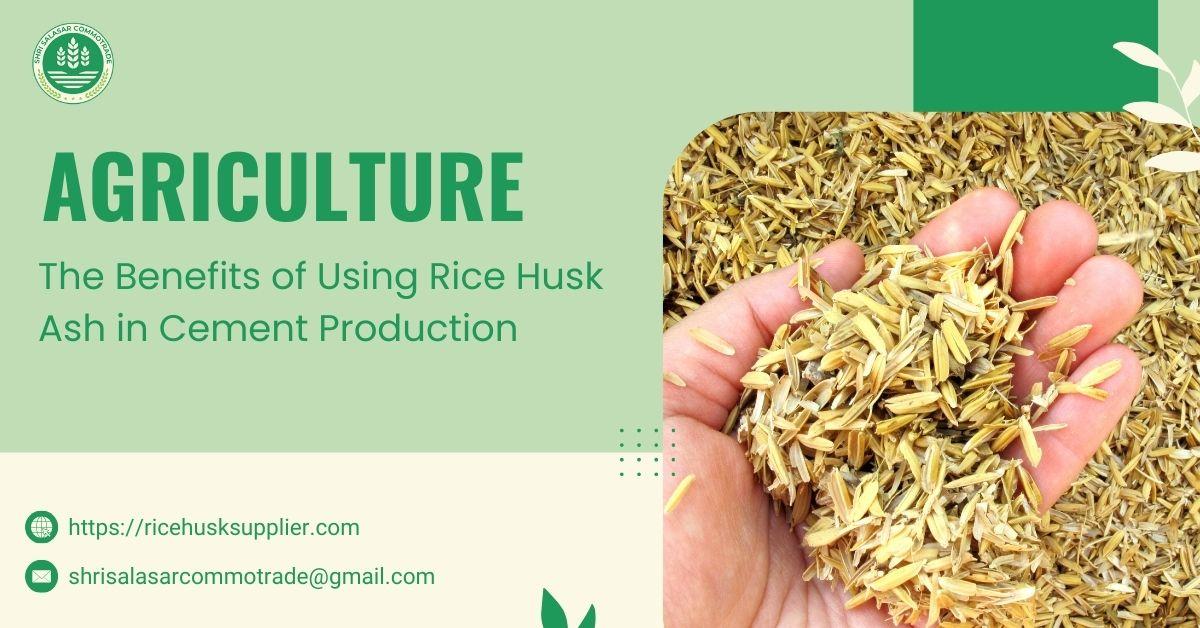Rice Husk Supplier is a byproduct obtained from burning rice husks. Traditionally considered agricultural waste, RHA has gained attention as an effective material in cement production. With increasing demand for sustainable construction materials, industries are looking for eco-friendly alternatives to conventional cement components. This article explores the benefits of using rice husk ash in cement production, its properties, applications, and overall impact on construction and the environment.
1. What is Rice Husk Ash?
Rice husk ash is produced by burning rice husks, which are the outer layers of rice grains. These husks contain silica, and when burned at controlled temperatures, they form RHA, which is rich in amorphous silica. This property makes RHA an excellent additive in cement and concrete production.
2. Chemical Composition of Rice Husk Ash
Rice husk ash contains high amounts of silica, along with small quantities of other compounds. Silica is the key ingredient that makes RHA suitable for use in cement, as it enhances the strength and durability of concrete.
3. Advantages of Using Rice Husk Ash in Cement Production
Using rice husk ash in cement offers multiple benefits in terms of sustainability, performance, and cost savings.
a) Improved Strength and Durability
RHA enhances the strength of concrete due to its pozzolanic properties. When mixed with cement, silica in RHA reacts with calcium hydroxide, forming additional calcium silicate hydrate (C-S-H), which strengthens concrete over time.
b) Reduces Cement Consumption
By partially replacing cement with RHA, the overall consumption of cement can be reduced. This leads to lower costs and decreases the environmental impact associated with cement production.
c) Eco-Friendly and Sustainable
Cement production is one of the largest contributors to carbon dioxide emissions. Using RHA as a cement additive helps in reducing the demand for clinker, the primary component in cement, thereby cutting carbon emissions and promoting sustainability.
d) Waste Management Solution
Rice husks are often discarded as waste in agricultural industries. Converting them into useful materials for cement production reduces waste accumulation and provides an effective way to recycle agricultural byproducts.
e) Increased Resistance to Chemicals
Concrete containing RHA has improved resistance to sulfate and acid attacks, making it ideal for structures exposed to harsh environmental conditions, such as marine structures and sewage treatment plants.
f) Reduced Water Permeability
Concrete with RHA has lower permeability, meaning it absorbs less water. This improves its durability and protects structures from moisture-related damage.
g) Cost-Effective Alternative
Since RHA is derived from an agricultural waste product, it is a low-cost alternative to traditional cement additives. This makes it an economical choice for construction projects.
4. How Rice Husk Ash is Used in Cement
RHA can be used in cement production in different ways:
-
As a Partial Replacement for Cement: RHA can replace 10%–30% of cement in concrete mixtures without compromising strength and durability.
-
As a Pozzolanic Material: When finely ground, RHA acts as a pozzolan, improving the overall performance of concrete.
-
As a Filler Material: RHA fills micro-pores in concrete, reducing voids and increasing density.
5. Applications of RHA-Based Cement in Construction
Rice husk ash cement is used in various construction applications, including:
-
Road Construction: RHA improves the durability of roads and reduces maintenance costs.
-
Building Foundations: The high strength and resistance to chemical attacks make RHA-based concrete ideal for foundations.
-
Bridges and Dams: RHA-based concrete is used in large infrastructure projects due to its long-lasting properties.
-
Marine and Coastal Structures: The reduced permeability of RHA-based concrete makes it suitable for marine environments where water resistance is essential.
-
Pavements and Flooring: Using RHA-based concrete in pavements and flooring enhances wear resistance and longevity.
7. Challenges in Using Rice Husk Ash in Cement
Despite its many benefits, there are some challenges in using RHA in cement production:
a) Quality Control Issues
The quality of RHA depends on the burning process. Improper burning can lead to the formation of crystalline silica, which is less reactive and unsuitable for cement applications.
b) Processing Costs
While RHA is a cost-effective material, the processing and grinding steps add to the overall cost.
c) Limited Awareness and Adoption
Many construction companies are still unaware of the benefits of RHA, which limits its widespread use.
8. Future Potential of Rice Husk Ash in the Cement Industry
With growing awareness of sustainable construction materials, RHA is expected to gain more popularity in the cement industry. Future developments include:
-
Better Processing Technologies: Improved methods for burning and grinding RHA to enhance its quality and performance.
-
Government Policies and Incentives: Encouraging the use of RHA through subsidies and environmental regulations.
-
Research and Innovation: Exploring new ways to use RHA in advanced construction applications.
9. Conclusion
Rice husk ash is a promising material in the cement industry, offering numerous benefits such as improved strength, sustainability, cost-effectiveness, and resistance to harsh conditions. By incorporating RHA into cement production, the construction industry can move toward more environmentally friendly practices while reducing costs and improving material performance. With continued research, technological advancements, and awareness, RHA has the potential to become a key component in the future of sustainable construction.



